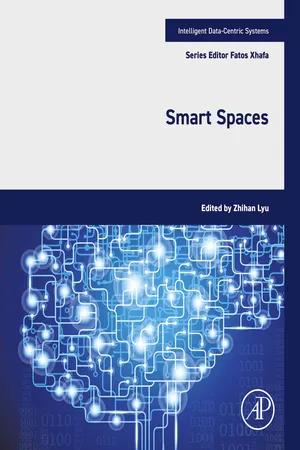
- 300 pages
- English
- ePUB (mobile friendly)
- Available on iOS & Android
Smart Spaces
About This Book
Smart Spaces combines the study of working or living spaces with computing, information equipment, and multimodal sensing devices, and with natural and convenient interactive interfaces to support how people can easily obtain services from computer systems. People's work and life in smart spaces use computer systems; it is a process of uninterrupted interaction between people and the computer system. In this process, the computer is no longer just an information processing tool that passively executes explicit human operation commands but a collaborator with people to complete tasks – a partner to human beings. International research on smart spaces is quite extensive, which shows the important role of smart spaces in ubiquitous computing research.
Smart Spaces covers the latest research concepts and technologies of smart spaces, providing technical personnel engaged in smart space related research and industries a more in-depth understanding of smart spaces. This book can be used as a reference for practicing the emerging discipline of Smart Spaces, and will be useful for researchers, scientists, developers, practitioners, and graduate students working in the fields of smart spaces and artificial intelligence.
- Comprehensively introduces smart spaces, from basic concepts, core technologies, technical architecture, application scenarios, and other aspects
- Covers the latest cutting-edge application technology of smart spaces in various fields, providing relevant practitioners with ideas to solve problems and have a deeper understanding of smart spaces
- Serves as teaching material or as a reference for teachers and students of interaction design, internet of things, ubiquitous and pervasive computing, and artificial intelligence
- Gives a detailed introduction to the theory of Smart Spaces and uses mathematical formulas
Frequently asked questions
Information
Table of contents
- Cover image
- Title page
- Table of Contents
- Copyright
- Contributors
- Chapter 1 Smart spaces: A review
- Chapter 2 An exploration of theory for smart spaces in everyday life: Enriching ambient theory for smart cities
- Chapter 3 Data fusion and homogenization: Two key aspects for building digital twins of smart spaces
- Chapter 4 Secured digital-twin data service for the Internet of smart things
- Chapter 5 Creating environmentally conscious products and environments with smart materials
- Chapter 6 IoT interoperability enhances smart and healthy living
- Chapter 7 Ecosystem of smart spaces: An overview review
- Chapter 8 Exploring the role of IoT for sustainable enhancement in smart spaces
- Chapter 9 Machine learning frameworks in IoT systems: A survey, case study, and future research directions
- Chapter 10 Augmented reality content and relations of power in smart spaces
- Chapter 11 Ensuring a harmonious state of smart space when there is a conflict of interest of its elements
- Chapter 12 Assessment and monitoring of human emotional state and behavior in a smart space environment
- Chapter 13 Digital twins for smart city
- Chapter 14 From smart city to smart urban spaces: Prerequisites for the formation of smart urban spaces based on the participation of residents in the largest cities of Russia
- Chapter 15 Smart and sustainable solutions for thriving tourism destinations
- Chapter 16 Design of a smart parking space allocation system for higher energy efficiency
- Chapter 17 Smart cities as spaces of flows and the digital turn in architecture and urban planning: Big data vis-à-vis environmental and social equity
- Chapter 18 Generative adversarial network (GAN) assisted IoT search engine for disaster damage assessment
- Chapter 19 Design and development of enhanced algorithm for the demarcation of ocean wakes from SAR imagery of rough sea conditions
- Chapter 20 Smart spaces and ensuring their information security
- Index